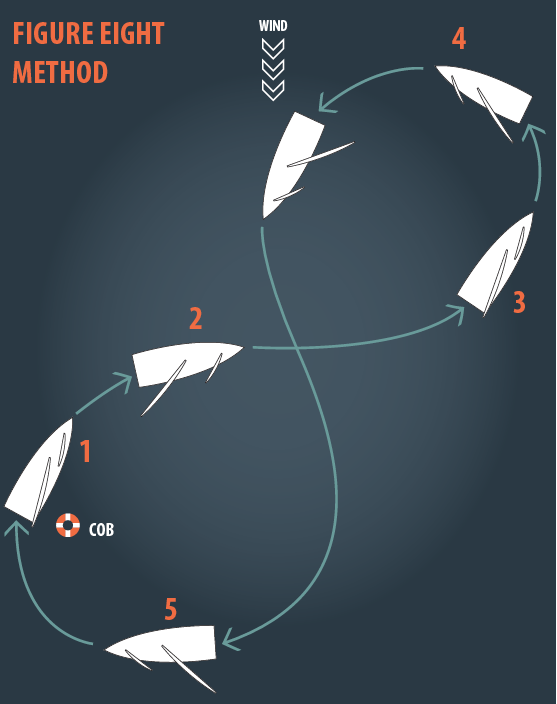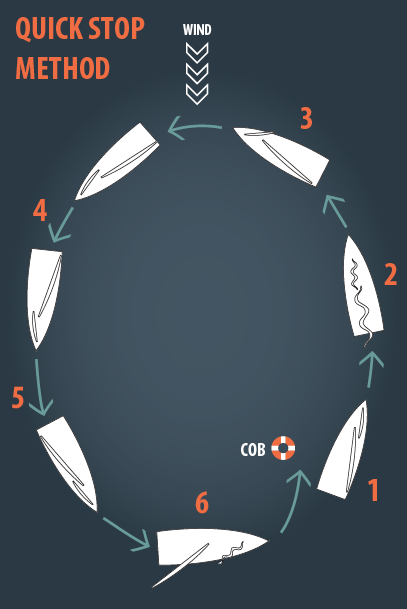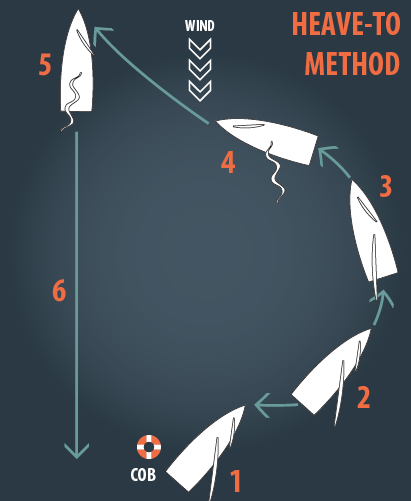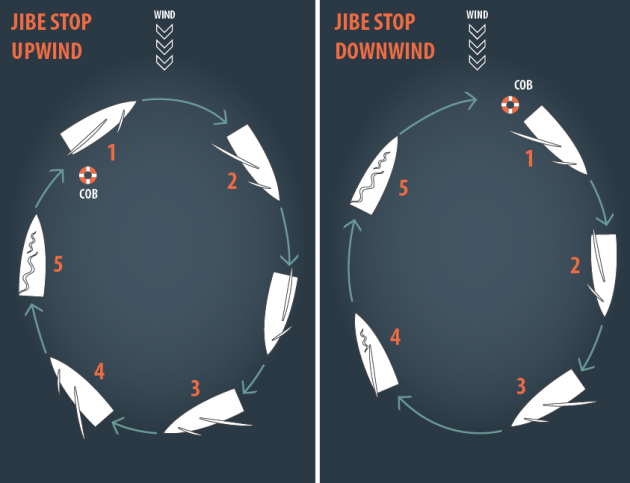Crew-overboard recovery
Crewmember-overboard recovery methods are constantly improving. As a sailing instructor, I've had the opportunity to teach, test and evaluate crew-overboard recovery methods hundreds of times. Some methods work better than others depending on the weather and sea conditions, the kind of sailboat and the experience level of the crew.
There are several ways to get a person back on board. While they differ in their steps and approach, they all have a few things in common. The first thing that should happen is that the crew is made aware of the situation by someone hailing, "Man overboard." Immediately after that at least one person on the boat should take over as the spotter. This person does nothing else during the recovery other than point at the crewmember in the water. Other crewmembers on the boat should immediately throw any available flotation at the victim as well as activate a Man-Overboard Module, if the boat is equipped with one, and activate the crewmember overboard button on the GPS. A calm, level-headed approach to recovery is always better than something that resembles a fire drill, and the more you practice, the better you will get.
The figure eight method
1. Regardless of which point of sail you are on when a crewmember falls overboard, the figure eight method starts with yelling "Man overboard," throwing flotation devices and appointing a spotter.
2. The helmsman should immediately either head up or bear away (depending on which point of sail the boat is on) to a beam reach.
3. Sail six to eight boatlengths on a beam reach.
4. Tack and immediately bear away from the wind to a broad reach, but only briefly until you cross your wake.
5. Head up to a close reach, ease the sheets and pick the victim up on the leeward side with speed between 1 and 2 knots and sails luffing.
Pros: The figure eight method is a classic approach often taught to beginning sailors on smaller vessels. Since it does not require a jibe, this method eliminates the potential danger of an uncontrolled boom flying across the cockpit and banging somebody in the head or damaging the rigging.
Cons: The biggest concern is the requirement of heading six to eight boatlengths away from the victim before returning. Considering the only thing the spotter might see is the victim's head in the water, unless the victim is waving, it would be easy to lose sight of them at such distances, especially in rougher conditions or when sailing offshore.
There are other things that can go wrong with the execution of the figure eight method. Often the helmsperson will not immediately head up or bear away to a beam reach or won't remain on the beam reach long enough, either of which will throw the whole thing off. They might otherwise stay on a broad reach for too long, wind up too far downwind of the victim, and then have to tack once or more to get back. Even when accomplished flawlessly, retrieving the victim from the water at the prescribed speed of between one and two knots is a challenge. Practicing with a buoy is one thing; a real person is quite another. If the victim in the water is unconscious, this drawback alone could be fatal.
The quick stop method

There are several different takes on how the quick stop maneuver is performed, but this is the most common version.
1. Shout "Man overboard," throw flotation devices overboard and appoint a spotter.
2. The helmsman points the boat directly into the wind and comes to a stop or near stop.
3. Leaving the sheets alone, backwind the jib or genoa and tack.
4. Sail downwind in a circle around the person in the water.
5. Release the jib or genoa sheet and jibe the boat.
6. Head back toward the victim on a close reach with sails luffing and pick them up on the leeward side. Variations of this method include furling or dropping the forward sail when heading downwind or approaching the victim close hauled or head to wind rather than on a close reach.
Pros: The quick stop method is faster than the figure eight method.
Cons: Heading straight into the wind and coming to a stop or near stop right away doesn't make any sense unless the skipper plans to stay there and the person in the water can swim quickly enough back to the boat. Otherwise, doing so is only wasting time and slowing down the tack. Tacking, sailing around and downwind of the victim before jibing is also wasting time. Why not skip the first two steps and jibe right away? Explanations of the quick stop method almost always assume the vessel is sailing to windward when somebody goes overboard. What if the vessel is sailing downwind? It would prove difficult and time consuming to head up and tack back around the person who went over the side. Jibing straight back to them would be faster. The quick stop final approach is a close reach and may not allow the vessel to slow down enough to retrieve somebody from the water.
The heave-to method

1. When someone falls overboard, first shout "Man overboard," throw flotation devices and appoint a spotter.
2. The helmsman heads up from whatever point of sail the boat is on and trims the forward sail all the way in.
3. Tack without releasing the forward sail so that it backwinds.
4. Ease the mainsheet all the way.
5. Turn hard into the wind and keep the wheel or tiller there, but avoid coming back through the wind.
6. Drift towards the person in the water and pick them up on the leeward side. Shout for them to swim to the boat if the boat is not drifting directly towards them.
Pros: The heave-to method is the fastest crew overboard recovery technique when everything goes well.
Cons: The results are unpredictable. In heavier winds, the hove-to boat will drift sideways faster than the victim can swim, especially with all their clothes on or when wearing a life jacket. Also, when the timing is off, the boat winds up stalled too far away from the person in the water. Although this method works swiftly in light wind, the helmsperson is left with zero steering control and the vessel is still moving.
The jibe stop method

The jibe stop method is performed differently depending on if you are sailing upwind or downwind at the time a crewmember falls overboard.
Sailing upwind:
1. If sailing to windward, when a crewmember falls overboard, first shout "Man overboard," throw flotation devices and appoint a spotter.
2. Simultaneously bear away from the wind and begin to jibe. The mainsail will likely be trimmed in enough already, but if not, either a crewmember or the helmsman should center the mainsail before completing the jibe.
3. Jibe the boat.
4. Resist the urge to head straight back to the person overboard and instead head for a point directly downwind of them. Stopping distances will vary among different vessels and in different conditions, but between one and two boatlengths downwind is about right.
5. Head directly into the wind, sails luffing and come coasting to a complete stop next to the person in the water.
Sailing downwind:
1. If sailing downwind, when a crewmember falls overboard, first shout "Man overboard," throw flotation devices and appoint a spotter.
2. Have a crewmember center the mainsail by pulling the mainsheet in hand-over-hand as quickly as possible. Do not use a winch handle as doing so will take too long.
3. Jibe the boat.
4. Release the jib or genoa sheet completely as you reach a point directly downwind of the victim.
5. Return to the victim from directly downwind with sails luffing and come coasting to a complete stop next to them and pull the person onboard.
Pros: On the water trials have shown the jibe stop method is approximately twice as fast as the quick stop approach and six to eight times faster than the figure eight method. The boat will not drift sideways as it does with the heave-to method.
Cons: Without practice, it is common for the boat to stop too far downwind of the victim. The engine can be used if it is safe to do so. The engine will be needed whenever there is a delay completing the jibe and quite likely whenever attempting this with a catamaran, which will usually stop faster head to wind than a monohull. Should you decide to use the engine, it is absolutely vital to ensure the transmission is in neutral on final approach and always remember to avoid overexposing anyone to the engine's exhaust fumes. Of course it is imperative that you make sure no lines are overboard before putting the engine in gear.
The jibe stop maneuver can be dangerous if crewmembers cannot center the boom (for whatever reason) before jibing and it requires a bit more in the way of boat-handling skills than some other methods, making it more difficult on some boats or with less experienced crews.
Retrieval from the water
The best way to retrieve a crewmember from the water depends on the boat's design and the victim's abilities. If the victim can climb, deploy a boarding ladder. If they are unable to climb or no ladder is available, attach a Lifesling, or similar device, to a spare halyard and hoist them aboard. If you are unsure of your ability to hoist the victim using a winch, acquire a block and tackle system for this purpose, practice using it beforehand, hoist the tackle on a spare halyard or topping lift and proceed retrieving them from the water.
An unconscious person overboard is a tricky scenario. Regardless of whatever advice is provided here, if your friend or loved one is unconscious and face down in the water, you're probably going to grab whatever floats and dive right in after them. Doing so is justifiable if the victim is face down in the water and leaving the boat will not jeopardize your life as well. First, make sure somebody who is capable of stopping the boat completely alongside and picking both you and the victim up stays onboard. Bring two life jackets and a line attached to you and the boat or a single life jacket and a Lifesling. Once the boat is stopped alongside, place the Lifesling or a bowline under the victim's arms for hoisting them aboard.
Do whatever it takes to save the unconscious victim, but use common sense above all. When an unconscious victim is floating face up, stay aboard the boat! Proceed as you normally would for a crew overboard recovery: Come to a complete stop alongside them, and hoist them from the water. The bulkier Type I life jackets are the only ones designed to float an unconscious victim face up in the water every single time. As they are somewhat awkward, however, most sailors choose not to wear them.
Managing the spinnaker
Most crew overboard methods are complicated by having to manage a spinnaker. With the figure eight method, dousing the spinnaker can usually be accomplished while on the beam reach. With the quick stop and the jibe stop methods, the spinnaker is a major concern because it will backwind into the rigging and result in a loss of steering control if not dropped or doused before pointing the boat into the wind. As the boat comes head to wind, ease the spinnaker pole to the headstay and douse the chute. The key is to douse the chute as quickly as possible without losing control or getting the boat into a bigger problem. Losing the chute in the water will only stop the boat and delay getting back to the crewmember overboard. Getting rid of the spinnaker causes delay in these scenarios, so consider safely using the engine.
Keep in mind that a crewmember who is wearing a PFD will be easier to spot in the water and will likely be able to survive longer in adverse conditions. Using a safety harness can help prevent losing people overboard in the first place.
Preventing a crewmember going overboard is the best plan, but you should be prepared for the possibility of somebody falling overboard and know what to do when it happens. Get out there, experiment, and master your favorite of these crewmember overboard recovery methods. Practice is key to successful overboard recoveries. Regardless of whether you will ever actually need it, doing so is a perfect excuse to get out on the water, which is always a brilliant way to spend the afternoon.
Mike Kohl teaches sailing at Newport Beach Sailing School in California, named American Sailing Association's Outstanding School of the Year for 2012. He is a two-time recipient of ASA's Outstanding Instructor of the Year award, which designates only the top sailing instructors worldwide. He also holds a 100-ton master's license from the United States Coast Guard.

Comments